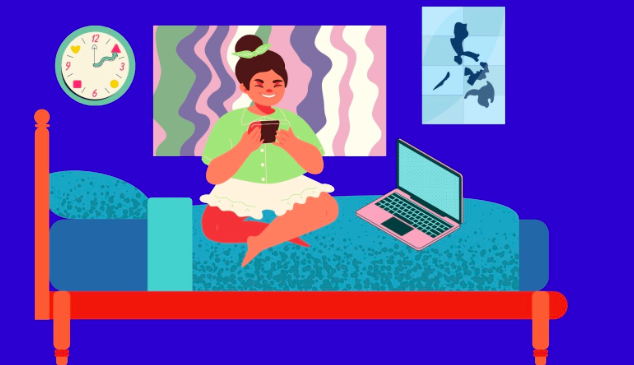Technical difficulties and a lack of non-verbal cues can make networking less personable online, says Toronto psychologist

Ryerson student Hayden Godfrey prides himself on having that extra sparkle when it comes to networking. He loves participating with enthusiasm and he tries to genuinely connect with whoever he is speaking to. He mirrors their body language during conversation and he tries to find unique identifiers to use in his follow-up emails to distinguish himself from the pack.
However, networking online is another ballpark.
“It’s been more difficult to grow my network in this past year, but at the same time, as cheesy as it sounds, it’s made me a better hustler and networker in the industry,” says Godfrey, a third-year professional communication student.
“You can’t rely on a physical presence anymore, and now you have to choose words more carefully. You can’t rely on someone’s impression of you physically and spatially.”
Building your industry network can feel uncomfortable when you’re a student — you have little to offer in terms of experience and a whole lot to ask of those who do.
For upper-year students at Ryerson University, building your network with professors, guest lecturers and industry professionals is critical to securing letters of reference and work after graduation. In the past year, students have had to do so virtually because of the COVID-19 pandemic. And while networking online is by no means impossible, it does come with new challenges.
Saunia Ahmad, director of the Toronto Psychology Clinic, says networking online can feel uncomfortable because “online interactions are different, and not everything about our in-person interactions can be programmed into the online format.”
People rely on their body language and tone to convey what their words can’t, and studies show that up to 80 to 90 per cent of communication is non-verbal. Online platforms can’t always facilitate those physical cues.
Kathleen Barr, a third-year professional communication student, will soon be applying to master’s programs, and her time to secure references from her professors is dwindling.
“You’re not getting to know professors that well when your mic and your camera are turned off,” she says. “Getting references at this point is a bit worrisome. I had great connections with my professors in first year, but to hit them up years later, they might not remember me.”
Barr says networking is everything in her industry, and while she has managed to grow her connections substantially this last year over social media, her attempts to connect with professors and guest lectures have been less fruitful.
“Lots of people in my program used to participate in guest lectures and then go and introduce themselves after, but you don’t really do that online because it’s awkward,” she says, “When class ends, it just ends. No one gets to stay afterward.”
Ahmad says she has “often found in group networking events and meetings that people are unsure if they should speak up or wait for someone else to speak up because we don’t see the non-verbal cues of someone else wanting to speak.”
This also applies to Zoom classes. Barr finds that “the biggest challenge is having to put yourself out there on a Zoom call. I’m usually all for participating in class, but there’s just something very awkward about Zoom conference calls.”
Because people’s reactions are hard to see, she says, “it feels like you’re talking to your computer screen alone in your childhood bedroom.”

While online networking certainly has its downfalls, it’s not without perks too. Jemma Dooreleyers, a fourth-year journalism student, actually prefers online networking.
“I find it easier to speak up and engage over Zoom because I feel like I’m not butting in or taking up anybody’s time,” she says.
Dooreleyers values being able to take a minute off-camera to collect herself if she feels anxious during class. She also likes that she can look up guest lecturers during class to gain more insight and, in turn, ask them better questions.
However, Ahmad says you can lose a lot in online group interactions, from side conversations to casual introductory and goodbye conversations that can seem unimportant but actually deepen our connections.
Godfrey met one of his mentors at a networking event before the COVID-19 pandemic, and in a follow-up email, he cheekily identified himself as the guy drinking Coke Zero. This playful banter serves to remind a person of who you are and isn’t as easy to replicate in a virtual environment because you don’t have the luxury of casual conversation or interaction over Zoom.
Technical challenges also impact the virtual networking environment.
“Some of the technical difficulties can make interactions… flow a bit differently,” says Ahmad. “It creates an environment that’s awkward because people are like, ‘did you hear me?] I know sometimes I have to hurry up and talk because the internet connection is coming in and out, so it just creates a different feel.”
However, there are ways to network successfully virtually, and Dooreleyers, Godfrey, and Barr are all proof of that. Both Godfrey and Barr say they have grown their professional networks in the past year by getting creative and reaching out to people virtually.
Ahmad suggests that students focus on learning how to be very assertive and clear about their interests while networking virtually, and make sure to follow up with potential connections.
She also stresses the importance of being succinct in follow-up. Students should first ask if it is okay to follow up with a person, she says, and what form of contact that person prefers.
“When you follow up, you can deepen a connection,” she says. “People who are looking to hire have so many people approaching them that when you see someone is interested in truly following up with you more, you think this might be someone who’s really a good fit for our business.”
